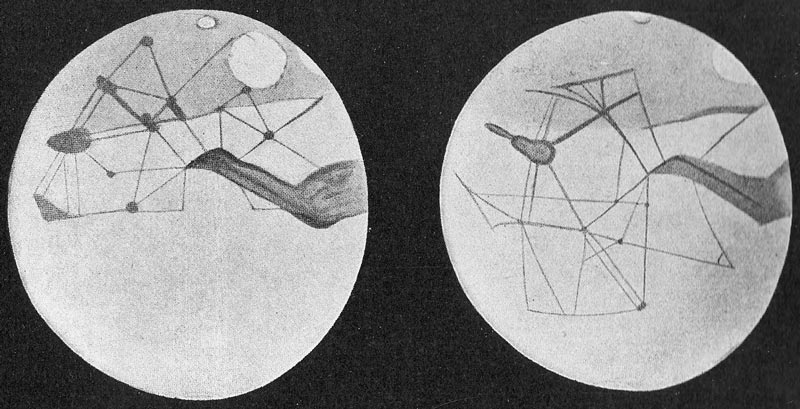“No one would have believed in the last years of the nineteenth century that this world was being watched keenly and closely by intellegences greater than man’s…”
So began H.G. Wells’ classic 1898 novel War of the Worlds. Wells, of course, was describing a vision of Mars occupied by an advanced race. That stands in stark contrast to the movie The Martian, which focuses on the isolation of an astronaut left stranded on the red planet. In a sense, that movie completes a transformation of the public’s perception of Mars underway since the Mariner 4 mission transmitted pictures of the Martian surface fifty years ago. While we can say that astronomy and the space age have played a key role in that transformation, it was also astronomers who provided the previous impression that Mars might be inhabited as well.
Prior to the 1990’s, no planets were known to exist outside our Solar System. There was a sense that such planets did exist of course, science fiction like Star Trek is proof of that. Giordano Bruno postulated as far back in the late 1500’s that, “numerable suns exist; innumerable earths revolve around these suns in a manner similar to the way the seven planets revolve around our sun. Living beings inhabit these worlds.” That, along with a lot of other things, did not endear Bruno to the Catholic Church and he was burned at the stake for his troubles in 1600. Nonetheless, without concrete observational proof of these planets, Mars seemed the best known candidate for life to exist beyond Earth.
In 1698, Christiaan Huygens published Cosmotheoros, which speculated about not only life on Mars but on the other planets in the Solar System as well. Of Mars Huygens wrote, “But the inhabitants…our Earth must appear to them almost as Venus doth to us, and by the help of a telescope will be found to have its wane, increase, and full, like the Moon.” Huygens was the first to discern Saturn has rings and discovered the Saturn moon Titan. In 2005, ESA landed a probe on Titan named in Huygens’ honor. It remains the most distant landing attempted in space. While life on Mars was pure speculation on Huygens’ part, he was an accomplished astronomer. And as we can tell by the rover Curiosity image below, his description of what Earth looked like from Mars is close to the mark.

In 1784, William Herschel published On the Remarkable Appearances at the Polar Regions on the Planet Mars. Like Huygens, Herschel ranks as one of the great observational astronomers with the discovery of Uranus among his many accomplishments. And like Huygens, Herschel also speculated on the possibility of life on Mars, stating, ““And the planet (Mars) has a considerable but moderate atmosphere, so that its inhabitants probably enjoy a situation in many respects similar to our own.” Both Huygens and Herschel set the stage for the boldest claim by an astronomer regarding life on Mars.
Percival Lowell was a contemporary of H.G. Wells. Born in 1855, Lowell was a successful businessman who had an interest in astronomy. This interest intensified when Lowell read Giovanni Schiaparelli published maps of Mars with channels across the surface in the 1890’s. Schiaparelli was Italian, and the English version of his work translated the Italian word for channel -canalis – into canals. As Mars headed towards opposition (closest approach to Earth) in 1894, Lowell set off to Arizona to make observations. Perhaps with a strong preconception, or too much desire to make a groundbreaking discovery, Lowell published this drawing of Mars from his telescope.

Lowell speculated that intelligent life on Mars had built a series of canals to draw water from the polar ice caps to the mid-latitudes for irrigation. Lowell’s work was rejected by other astronomers who also observed Mars during opposition but did not note canals. Had Lowell been trained as a scientist, the lack of replication may had given him pause. However, trained as a businessman, Lowell marketed his case directly to the public. At first, through articles written for magazines such as the Atlantic Monthly, then through a series of books and continued defense of the canal theory until his death in 1916*. Though rebuffed by astronomers, Lowell’s work on Mars provided a framework for popular culture during the next half century.
Against this backdrop, Wells published War of the Worlds four years after Lowell’s first observation of Mars. Often lost in the subsequent radio and movie versions was Wells’ original intent to critique British colonialism, in particular, the concept of Social Darwinism. This concept stated that various nations that are stronger are morally justified in the subjugation of weaker societies in a survival of the fittest competition for resources. Wells’ point was, if that is the case, how could Britain complain if a stronger race colonized them? In America, of course, it is the Orson Wells 1938 radio broadcast version of the story that is most well known.
The legendary broadcast was made so with media reports of panic induced by the realistic reporting of a Martian invasion. However, the extent of the panic, if any existed at all, has been disputed. From Wells’ work on, Martians became a cottage industry in both print and film.
And that cottage industry was all over the map. From the classics such as Ray Bradbury’s The Martian Chronicles and Robert Heinlein’s Red Planet to horrendous efforts such as the movie Santa Claus Conquers the Martians, intelligent life from Mars was a staple in popular culture. Remarkably, astronomers were publishing papers as late as the 1950’s that vegetation might exist on Mars. Gerard Kuiper published a paper in the Astrophysical Journal during 1956 discussing the possibility of greenish moss (to be fair, Kuiper also postulated inorganic causes as well) on Mars during the spring/summer seasons. William Sinton published an article in 1958 suggesting spectroscopic evidence of vegetation on Mars. The concept of life on Mars would take a sobering turn in 1965.
Mariner 4 was launched on November 28, 1964 and begun its seven month journey to flyby Mars. This mission would be the first to bring close up images of another planet back to Earth. Prior to Mariner 4, astronomers had to rely on observatories which lacked digital CCD and adaptive optics technology available today. Below are images of Mars taken from the 100-inch telescope at Mt. Wilson in 1956.

What NASA got back from Mariner 4 in July, 1965 were images such as this:

The barren, cratered surface of Mars came as a disappointment. Mariner 4 also measured a very thin atmosphere and lack of magnetic field. As such, Mars does not have an ozone layer to protect organic compounds on the surface from ultraviolet radiation. Without a magnetic field, the surface of Mars is also bombarded by a toxic stew of cosmic rays. Quite simply, Mars is not capable of supporting life on a surface constantly exposed to harmful radiation from space. However, future missions to Mars made it clear it is an interesting planet in an all together different way. Much like the planet presented in The Martian.
In 1971, Mariner 9 became the first spacecraft to orbit a planet. As a result, this mission was able to provide a comprehensive map of the Martian surface. Imaging was delayed for two months by a massive dust storm, but once the imaging commenced, planetary scientists were delighted. Among the findings were the largest canyon and volcanic features in the Solar System later named Valles Marineris and Olympic Mons. Most importantly, Mariner 9 imaged ancient dry riverbeds and channels. Water did once flow on the surface of Mars, albeit billions of years ago. The success of Mariner 9 provided the impetus for Vikings 1 & 2, which landed on Mars in 1976 and gave us the first look at the surface. This is how the landing was covered by ABC including an interview with Carl Sagan.
Viking searched for life on Mars and found none at the landing zones. There was a 20 year lull in Mars exploration until 1997 when Pathfinder landed on Mars. Tagging along for the ride was the Sojourner rover, the first of the Mars rovers, named after the 19th century abolitionist Sojourner Truth. By 1997, the public had more access to NASA missions, specifically the mission website that provided updates and images. The original website is still online and can be accessed here.
By this time, it was problematic to present a story with Martians that had serious social commentary a la War of the Worlds. The notion of an advanced race on Mars could not be taken seriously and was reduced to efforts such as the 1996 comedy Mars Attacks. During the course of the 20th century, the public perception of Mars went from a planet that might have an advanced race, to a planet that might have vegetation, to a planet that while geologically interesting, was devoid of life. Conflict is the centerpiece of drama, and without the possibility of life on Mars, the traditional source of conflict had been removed.
Between Pathfinder landing on Mars in 1997 and its use as a plot device in 2015 in The Martian, there have been several orbiter, lander, and rover missions to Mars. Mars Odyssey has been in orbit since 2001 and rover Opportunity has been exploring the surface since 2004. NASA’s Mars Exploration website has images and video from all its active Mars missions. Among the rover images are dust devils which were a feature of the landscape in The Martian.
The results of these missions were used quite effectively to provide a reasonably accurate take on what living on Mars would look like in the movie. Without an alien race to provide drama, the central conflict is the harshness of space itself. The challenges of human travel to Mars include limited availability of launch windows (once every 26 months as Mars approaches opposition), protection from cosmic rays, landing significant tonnage on Mars with very little atmosphere to provide braking, physical deterioration caused by Mars low (30% of Earth’s) gravity, and utilizing recently discovered water resources below the surface. The last point also underscores the need to determine if microbial life exists in the subsurface of Mars where water still exists. Can we avoid contaminating Mars with microbial life from Earth and vise-versa? NASA has an Office of Planetary Protection dedicated to that last issue. Ironically, it was exposure to Earth’s microbes that did in the invading Martians to conclude H. G. Wells’ The War of the Worlds.
The Martian signifies that Hollywood has caught up with science in terms of presenting dramatic stories of Solar System exploration without intelligent life from Mars. The other side of the human vs. harshness of space conflict is the fact that while we may send a handful of astronauts to Mars the next few decades, the vast majority of humanity will remain on Earth. There will not be a mass migration to Mars if we foul things up on our home planet. If space exploration can help discover a means to solve the challenges we face on Earth during the same time we go to Mars, it may be finding the right combination of international competition vs. international cooperation. We can only hope that right mix may be found in reality as readily as it can be found in the movies.
*Percival Lowell’s true legacy to astronomy was founding the Lowell Observatory in Arizona where Pluto was discovered. In 2015, its 4.3 meter telescope became fully operational. You can check that out on the Lowell Observatory website.
**Image on top of post is Mars Pathfinder landing site in 1997, to be visited by Mark Watney in the future. Credit: NASA/JPL






























